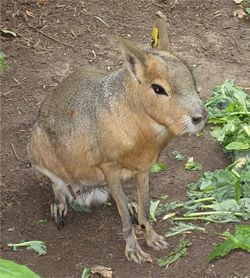Cavy
| Caviidae
| ||||||||||
|---|---|---|---|---|---|---|---|---|---|---|
 Mara, genus Dolichotis
| ||||||||||
| Scientific classification | ||||||||||
| ||||||||||
|
Caviinae |
The Cavy family (Caviidae) is a family of rodents native to South America, and including the domestic guinea pig, wild cavies, and the capybara, among other animals. They are found across the continent, in open areas from moist savanna to thorn forests or scrub desert.
Characteristics
With the exception of the maras, which have a more rabbit-like appearance, caviids have short, heavy bodies, and large heads. They have no visible tails. They range in size from the smaller cavies at 22cm in body length, and 300 grams in weight, up to the capybara, the largest of all rodents at 106 to 134 cm in length, and with a body weight of 35 to 66 kilograms. Even larger forms existed in the Pliocene, such as Phugatherium, which was about the size of a tapir[1].
They are herbivores, eating tough grasses or softer leaves, depending on species. The dental formula is similar to that of other rodents:
| 1.0.1.3 |
| 1.0.1.3 |
Females give birth to two or three furred and active young after a gestation period of 50 to 90 days in most species, or 150 days in the capybara. In most species, they are sexually mature within a few months of birth, although in capybaras, maturity is not reached until around 18 months[2].
Social organisation varies widely among the group. Many cavies are promiscuous, forming no long-lasting social groups, although, in some species, males maintain harems of two or more females. In contrast, maras are monogamous, and form temporary colonial creches to care for the young of multiple mothers. Capybaras live in groups of around ten individuals, and sometimes many more, each with a single dominant male, and a number of females, subordinate males, and juveniles[2].
Classification
Family Caviidae
- Subfamily Caviinae: Guinea pigs (cavies)
- Genus Cavia, this genus is especially called cavy.
- Genus Galea
- Genus Microcavia: Desert cavies
- Subfamily Dolichotinae
- Genus Dolichotis: Patagonian hares, or maras
- Subfamily Hydrochoerinae
- Genus Hydrochoerus: Capybara
- Genus Kerodon: Rock cavy
ReferencesISBN links support NWE through referral fees
- ↑ Savage, RJG, & Long, MR (1986). Mammal Evolution: an illustrated guide. New York: Facts on File, 125–126. ISBN 0-8160-1194-X.
- ↑ 2.0 2.1 Herrera, E., Lacher, T.E., Macdonald, D., & Taber, A.B. (1984). in Macdonald, D.: The Encyclopedia of Mammals. New York: Facts on File, 690–699. ISBN 0-87196-871-1.
- Woods, C. A. and C. W. Kilpatrick. 2005. Pp 1538-1600 in Mammal Species of the World a Taxonomic and Geographic Reference 3rd ed. D. E. Wilson and D. M. Reeder eds. Smithsonian Institution Press, Washington D.C.
|
Sciuromorpha: †Allomyidae | Aplodontiidae | †Mylagaulidae | †Reithroparamyidae | Sciuridae | Gliridae |
|
Castorimorpha: †Eutypomyidae | Castoridae | †Rhizospalacidae | †Eomyidae | †Heliscomyidae | †Mojavemyidae | Heteromyidae | Geomyidae |
|
Myomorpha: †Armintomidae | Dipodidae | Zapodidae | †Anomalomyidae | †Simimyidae | Platacanthomyidae | Spalacidae | Calomyscidae | Nesomyidae | Cricetidae | Muridae |
|
Anomaluromorpha: Anomaluridae | †Parapedetidae | Pedetidae |
|
Hystricomorpha: †Tamquammyidae | Ctenodactylidae | Diatomyidae | †Yuomyidae | †Chapattimyidae | †Tsaganomyidae | †"Baluchimyinae" | †Bathyergoididae | Bathyergidae | Hystricidae | †Myophiomyidae | †Diamantomyidae | †Phiomyidae | †Kenyamyidae | Petromuridae | Thryonomyidae | Erethizontidae | Chinchillidae | Dinomyidae | Caviidae | Dasyproctidae | †Eocardiidae | Cuniculidae | Ctenomyidae | Octodontidae | †Neoepiblemidae | Abrocomidae | Echimyidae | Myocastoridae | Capromyidae | †Heptaxodontidae |
|
Prehistoric rodents (incertae sedis): †Eurymylidae | †Cocomyidae | †Alagomyidae | †Ivanantoniidae | †Laredomyidae | †Ischyromyidae | †Theridomyidae | †Protoptychidae | †Zegdoumyidae | †Sciuravidae | †Cylindrodontidae |
|
† indicates extinct taxa |
Template:Caviidae nav
Credits
New World Encyclopedia writers and editors rewrote and completed the Wikipedia article in accordance with New World Encyclopedia standards. This article abides by terms of the Creative Commons CC-by-sa 3.0 License (CC-by-sa), which may be used and disseminated with proper attribution. Credit is due under the terms of this license that can reference both the New World Encyclopedia contributors and the selfless volunteer contributors of the Wikimedia Foundation. To cite this article click here for a list of acceptable citing formats.The history of earlier contributions by wikipedians is accessible to researchers here:
The history of this article since it was imported to New World Encyclopedia:
Note: Some restrictions may apply to use of individual images which are separately licensed.